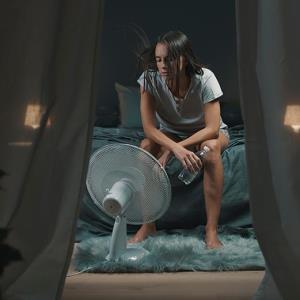Exposure to extreme nighttime heat appears to raise the risk of stroke events especially for older adults, women, and individuals with a history of minor strokes, according to a study.
Data on 11,037 cases of hospitalization for stroke (average age of patients 71.3 years) collected over 15 years (2006–2020) in Augsburg, Germany, showed that the odds of experiencing a stroke event were 14-percent higher on days with extreme nighttime heat (97.5 percentile of Hot Night Excess Index [HNE]: odds ratio [OR], 1.14, 95 percent confidence interval [CI], 1.01–1.32) in a model that controlled for daytime temperature. [Eur Heart J 2024;doi:10.1093/eurheartj/ehae277]
Of note, the odds of experiencing nighttime heat-related stroke events significantly increased in the recent period than in the earlier period (2013–2020: OR, 1.33, 95 percent CI, 1.18–1.50 vs 2006–2012: OR, 0.99, 95 percent CI, 0.91–1.08; p=0.03). This increase was pronounced for the ischaemic stroke subtype (2013–2020: OR, 1.32, 95 percent CI, 1.16–1.49 vs 2006–2012: OR, 0.99, 95 percent CI, 0.91–1.09; p=0.03) but less so for the haemorrhagic stroke subtype (2013–2020: OR, 1.21, 95 percent CI, 1.02–1.48 vs 2006–2012: OR, 0.98, 95 percent CI, 0.85–1.15; p=0.48).
From 2006 to 2012, hot nights were attributed to an average of two extra strokes per year. This number jumped to an average of 33 extra stroke cases annually from 2013 to 2020, said the researchers, led by Dr Alexandra Schneider of Helmholtz Zentrum München—German Research Center for Environmental Health in Neuherberg, Germany.
Certain groups of people were especially vulnerable to stroke during hot nights, and this risk increased over time, Schneider added.
Between 2006–2012 and 2013–2020, a significant rise in nighttime heat-related stroke risk was seen in subgroups of women (OR, 1.02 to OR, 1.33), individuals over 60 years of age (OR, 0.99 to OR, 1.36), and those with a history of minor strokes (OR, 1.04 to OR, 1.52).
“These findings suggest that exposure to nighttime heat should be considered a potentially preventable trigger of stroke events under a warming climate, especially given that the intensity of future warming at night is projected to be significantly higher than increases in daytime temperature,” Schneider said.
More frequent hot nights
During the recent period, average daily temperatures during the warm season increased slightly, from 14.5°C in 2006–2012 to 14.8°C in 2013–2020 (p>0.05). The same was true for the daily maximum temperature (from 19.6°C to 20.3°C). More importantly, the frequency of nights with extreme heat went up from 79 days to 82 days.
Dehydration, elevated blood viscosity, and alterations in blood vessel functioning might explain the rise in ischaemic stroke events during recent hot nights, Schneider pointed out, adding that such effects could worsen with the occurrence of more frequent extremely hot nights.
Meanwhile, the link between nighttime heat exposure and haemorrhagic strokes wasn’t as well defined in this study, possibly because there were not enough cases to analyse, according to Schneider. However, she stressed that hot weather could lead to hypertension, which is a known risk factor for haemorrhagic strokes.
While future studies using multicentre stroke registries are warranted to confirm the findings in other geographic areas, the study underscores the need for public health strategies to address the increasing risk of strokes associated with exposure to extreme nighttime heat, according to the researcher.
Schneider called for healthcare systems to prioritize implementation of heat health action plans that include targeted messaging and allocating resources to mitigate the risks of nocturnal heat exposure. At the community level, she added, interventions such as providing education on heat-related illness prevention and improving urban green spaces can also help protect vulnerable populations.
“Lastly, policymakers should consider integrating climate adaptation measures into urban planning, including implementing heat-resilient infrastructure and urban greening initiatives to reduce the urban heat island effect and mitigate the impact of rising nighttime temperatures,” Shneider said.

